
The two most-read GI stories of 2022 focused on the U.S. Food and Drug Administration — its clearance of a single-use gastroscope and an updated safety communication urging providers to transition to innovative duodenoscope models.
An update to prominent reprocessing guidelines and the response issued by several GI societies was another top post this year. Reprocessing concerns and challenges were well-represented on this list.
Check out the 10 most-read GI stories on Single-Use Endoscopy from the past year. We hope you'll revisit them and continue to read Single-Use Endoscopy. Click here to sign up for our newsletters.
10. Analyzing Endoscope Reprocessing Differences Between the U.S. and Europe
No matter where in the world you may reprocess a GI endoscope, the process differs little. There are manufacturers’ instructions for use, local regulations, and society guidelines to follow.
And everyone follows them to the best of their ability, according to clinical training specialist Nick Bromiley on the Beyond Clean podcast. The whole system, however, “is flawed,” he added. “The cards are stacked against successful reprocessing.”
9. Day 1 Report: Digestive Disease Week 2022
In making his case for the adoption of single-use duodenoscopes, Dr. Klaus Mergener described what the first duodenoscopes looked like upon their invention more than five decades ago.
The description was strikingly similar to the duodenoscopes of today.
His DDW presentation, “Disposable Scopes Versus Better Reprocessing: Throw It Out,” made a compelling case for single-use endoscopes in gastroenterology, including the innovation they bring to a space that had lacked it for decades.
8. No Outbreak, No Problem? Duodenoscopes May Still Harbor Contamination
Even without an infection outbreak, duodenoscopes may still be contaminated.
In fact, a study including 16 clinical sites across the U.S. detected a 5.3 percent contamination rate of duodenoscopes after reprocessing in non-outbreak settings.
7. Survey: Reprocessing Departments Face Staff Shortages and Pressure to Work Quickly
Staff tasked with reprocessing reusable duodenoscopes face pressure to work quickly and must navigate shortages of trained workers.
Amanda D. Sivek and her fellow co-investigators from ECRI, a Pennsylvania nonprofit that specializes in evaluating the safety of equipment and practices in healthcare, discovered these and other “alarming” trends from a survey seeking the feedback from professionals who do the important work.
6. What is an ‘Acceptable Rate’ of Infection Risk from Reprocessed Duodenoscopes?
Though duodenoscope reprocessing is considered highly effective, the process is not without risk.
Recent years have seen increased emphasis on reprocessing and a focus on the risk of infection associated with reprocessed gastrointestinal endoscopes, the authors of a review published in Techniques and Innovations in Gastrointestinal Endoscopy write. The researchers outlined such risks and the reprocessing challenges, and also analyzed available enhanced reprocessing methods and quality indicators to test reprocessing effectiveness.
Additionally, the review dives into a novel technology which lowers the risk of exogenous infection during ERCP procedures — single-use duodenoscopes.
5. Reviewing the Efficacy of Duodenoscope Reprocessing Techniques
Implementing supplemental reprocessing measures proposed by the U.S. Food and Drug Administration has not led to lower contamination rates of reusable duodenoscopes.
That’s one conclusion drawn in a narrative review of current duodenoscope reprocessing techniques and novel developments that advance or eliminate reprocessing. The authors of the review shared their findings in the Antimicrobial Resistance and Infection Control Journal.
4. PODCAST: Ergonomics Challenges in GI Endoscopy
Dr. Marybeth Spanarkel loved the “immediate gratification” in performing a colonoscopy or upper GI endoscopy and getting an immediate answer to a medical question.
Unfortunately, she had to step away from the field after 28 years in private practice in Durham, North Carolina, after a career-ending neck injury that caused sudden paralysis in her right arm. That musculoskeletal injury brought her career to an end, but it was the catalyst sending her down a new path.
3. AAMI Responds to GI Societies’ ST91 Rebuttal
The Association for the Advancement of Medical Instrumentation (AAMI) published a strongly-written response rebuking a joint statement issued by several GI societies opposing the organization’s updated guidelines for cleaning and disinfecting flexible and semi-rigid endoscopes.
AAMI published ANSI/AAMI ST91:2021, Flexible and semi-rigid endoscope processing in health care facilities in March. The following month, many GI societies released a joint statement saying changes to ST91 create obstacles to implementing standards and “offer impractical, inappropriate, or conflicting guidance.”
2. FDA Pushes for Switch to ‘Innovative’ Duodenoscope Designs to Enhance Patient Safety
The U.S. Food and Drug Administration has updated a safety communication on duodenoscopes and is recommending that hospitals and endoscopy facilities “complete transition to innovative duodenoscope designs” due to concerns about reprocessing and patient cross-contamination.
The FDA previously said hospitals should consider using duodenoscopes with disposable components or adopt fully single-use models. The agency issued this new update in part because of new postmarket surveillance studies on fixed endcap design duodenoscopes that found 4.1 percent to 6.6 percent of samples tested positive with what the agency calls high-concern organisms.
1. FDA Clears Ambu’s Single-Use Gastroscope
A single-use gastroscope has received 510(k) clearance from the U.S. Food and Drug Administration and could be on the market in the next few months.
The gastroscope — as well as a next-generation display unit — from Danish medical device company Ambu A/S is designed to be used once and discarded, protecting patients from possible device cross-contamination and addressing workflow challenges that arise when scopes are out of service being reprocessed or repaired.
Those challenges have been exacerbated, company executives say, by the COVID-19 pandemic, which has caused staff shortages at overtaxed healthcare and hospital systems.


